Antibiotic-Loaded Hydroxyapatite Ceramic in the Management of Diabetic Foot Osteomyelitis: An Investigation of Factors That Determine Patient Outcomes
Abstract
1. Introduction
2. Materials and Methods
3. Results
4. Discussion
5. Conclusions
Author Contributions
Funding
Institutional Review Board Statement
Informed Consent Statement
Data Availability Statement
Acknowledgments
Conflicts of Interest
References
- IDF Diabetes Atlas 2025. Diabetes Atlas. Available online: https://diabetesatlas.org/resources/idf-diabetes-atlas-2025/ (accessed on 9 March 2025).
- Boulton, A.J.M.; Armstrong, D.G.; Albert, S.F.; Frykberg, R.G.; Hellman, R.; Kirkman, M.S.; Lavery, L.A.; LeMaster, J.W.; Mills, J.L.; Mueller, M.J.; et al. Comprehensive Foot Examination and Risk Assessment: A Report of the Task Force of the Foot Care Interest Group of the American Diabetes Association, with Endorsement by the American Association of Clinical Endocrinologists. Diabetes Care 2008, 31, 1679–1685. [Google Scholar] [CrossRef] [PubMed]
- Edo, A.; Edo, G.; Ezeani, I. Risk Factors, Ulcer Grade and Management Outcome of Diabetic Foot Ulcers in a Tropical Tertiary Care Hospital. Niger. Med. J. 2013, 54, 59. [Google Scholar] [CrossRef]
- Guest, J.F.; Fuller, G.W.; Vowden, P. Diabetic Foot Ulcer Management in Clinical Practice in the UK: Costs and Outcomes. Int. Wound J. 2017, 15, 43–52. [Google Scholar] [CrossRef] [PubMed]
- Armstrong, D.G.; Wrobel, J.; Robbins, J.M. Guest Editorial: Are Diabetes-Related Wounds and Amputations Worse than Cancer? Int. Wound J. 2007, 4, 286–287. [Google Scholar] [CrossRef]
- Singh, V.P.; Bali, A.; Singh, N.; Jaggi, A.S. Advanced Glycation End Products and Diabetic Complications. Korean J. Physiol. Pharmacol. 2014, 18, 1. [Google Scholar] [CrossRef]
- Vouillarmet, J.; Maucort-Boulch, D.; Michon, P.; Thivolet, C. Advanced Glycation End Products Assessed by Skin Autofluorescence: A New Marker of Diabetic Foot Ulceration. Diabetes Technol. Ther. 2013, 15, 601–605. [Google Scholar] [CrossRef]
- Armstrong, D.G.; Boulton, A.J.M.; Bus, S.A. Diabetic Foot Ulcers and Their Recurrence. N. Engl. J. Med. 2017, 376, 2367–2375. [Google Scholar] [CrossRef]
- Lavery, L.A.; Peters, E.J.G.; Armstrong, D.G.; Wendel, C.S.; Murdoch, D.P.; Lipsky, B.A. Risk Factors for Developing Osteomyelitis in Patients with Diabetic Foot Wounds. Diabetes Res. Clin. Pract. 2009, 83, 347–352. [Google Scholar] [CrossRef] [PubMed]
- Lavery, L.A.; Ryan, E.C.; Ahn, J.; Crisologo, P.A.; Oz, O.K.; La Fontaine, J.; Wukich, D.K. The Infected Diabetic Foot: Re-Evaluating the IDSA Diabetic Foot Infection Classification. Clin. Infect. Dis. 2019, 70, 1573–1579. [Google Scholar] [CrossRef]
- Thabit, A.K.; Fatani, D.F.; Bamakhrama, M.S.; Barnawi, O.A.; Basudan, L.O.; Alhejaili, S.F. Antibiotic Penetration into Bone and Joints: An Updated Review. Int. J. Infect. Dis. 2019, 81, 128–136. [Google Scholar] [CrossRef]
- Ferguson, J.; Athanasou, N.; Diefenbeck, M.; McNally, M. Radiographic and Histological Analysis of a Synthetic Bone Graft Substitute Eluting Gentamicin in the Treatment of Chronic Osteomyelitis. J. Bone Jt. Infect. 2019, 4, 76–84. [Google Scholar] [CrossRef] [PubMed]
- Metaoy, S.; Rusu, I.; Pillai, A. Adjuvant Local Antibiotic Therapy in the Management of Diabetic Foot Osteomyelitis. Clin. Diabetes Endocrinol. 2024, 10, 51. [Google Scholar] [CrossRef] [PubMed]
- NICE. Overview|Overweight and Obesity Management|Guidance|NICE. Nice.org.uk. Available online: https://www.nice.org.uk/guidance/ng246 (accessed on 9 March 2025).
- Braatvedt, G.D.; Cundy, T.; Crooke, M.; Florkowski, C.; Mann, J.I.; Lunt, H.; Jackson, R.; Orr-Walker, B.; Kenealy, T.; Drury, P.L. Understanding the New HbA1c Units for the Diagnosis of Type 2 Diabetes. N. Z. Med. J. 2012, 125, 70–80. [Google Scholar] [PubMed]
- Overview|Chronic Kidney Disease in Adults: Assessment and Management|Guidance|NICE. Nice.org.uk. Available online: https://www.nice.org.uk/guidance/cg182 (accessed on 9 March 2025).
- Meijer, W.T.; Hoes, A.W.; Rutgers, D.; Bots, M.L.; Hofman, A.; Grobbee, D.E. Peripheral Arterial Disease in the Elderly. Arterioscler. Thromb. Vasc. Biol. 1998, 18, 185–192. [Google Scholar] [CrossRef]
- Drampalos, E.; Mohammad, H.R.; Kosmidis, C.; Balal, M.; Wong, J.; Pillai, A. Single Stage Treatment of Diabetic Calcaneal Osteomyelitis with an Absorbable Gentamicin-Loaded Calcium Sulphate/Hydroxyapatite Biocomposite: The Silo Technique. Foot 2018, 34, 40–44. [Google Scholar] [CrossRef]
- Niazi, N.S.; Drampalos, E.; Morrissey, N.; Jahangir, N.; Wee, A.; Pillai, A. Adjuvant Antibiotic Loaded Bio Composite in the Management of Diabetic Foot Osteomyelitis—A Multicentre Study. Foot 2019, 39, 22–27. [Google Scholar] [CrossRef]
- Toyofuku, M.; Inaba, T.; Kiyokawa, T.; Obana, N.; Yawata, Y.; Nomura, N. Environmental Factors That Shape Biofilm Formation. Biosci. Biotechnol. Biochem. 2015, 80, 7–12. [Google Scholar] [CrossRef]
- Mottola, C.; Matias, C.S.; Mendes, J.J.; Melo-Cristino, J.; Tavares, L.; Cavaco-Silva, P.; Oliveira, M. Susceptibility Patterns of Staphylococcus Aureus Biofilms in Diabetic Foot Infections. BMC Microbiol. 2016, 16, 119. [Google Scholar] [CrossRef]
- Adithan, C.; Sriram, G.; Swaminathan, R.P.; Shashindran, C.H.; Bapna, J.S.; Krishnan, M.; Chandrasekar, S. Differential Effect of Type I and Type II Diabetes Mellitus on Serum Ampicillin Levels. Int. J. Clin. Pharmacol. Ther. Toxicol. 1989, 27, 493–498. [Google Scholar]
- Fejfarová, V.; Antalová, S.; Husáková, J.; Wosková, V.; Beca, P.; Polák, J.; Dubský, M.; Sojáková, D.; Petrlík, M. Does PAD and Microcirculation Status Impact the Tissue Availability of Intravenously Administered Antibiotics in Patients with Infected Diabetic Foot? Results of the DFIATIM Substudy. Front. Endocrinol. 2024, 15, 1326179. [Google Scholar] [CrossRef]
- Stravinskas, M.; Horstmann, P.; Ferguson, J.; Hettwer, W.; Nilsson, M.; Tarasevicius, S.; Petersen, M.M.; McNally, M.A.; Lidgren, L. Pharmacokinetics of Gentamicin Eluted from a Regenerating Bone Graft Substitute. Bone Jt. Res. 2016, 5, 427–435. [Google Scholar] [CrossRef]
- Nilsson, M.; Wang, J.-S.; Wielanek, L.; Tanner, K.E.; Lidgren, L. Biodegradation and Biocompatability of a Calcium Sulphate-Hydroxyapatite Bone Substitute. J. Bone Jt. Surg.—Br. 2004, 86, 120–125. [Google Scholar] [CrossRef]
- Masala, S.; Nano, G.; Marcia, S.; Muto, M.; Paolo, F.; Simonetti, G. Osteoporotic Vertebral Compression Fractures Augmentation by Injectable Partly Resorbable Ceramic Bone Substitute (CeramentTM|SPINE SUPPORT): A Prospective Nonrandomized Study. Neuroradiology 2011, 54, 589–596. [Google Scholar] [CrossRef] [PubMed]
- Hatten, H.P.; Voor, M.J. Bone Healing Using a Bi-Phasic Ceramic Bone Substitute Demonstrated in Human Vertebroplasty and with Histology in a Rabbit Cancellous Bone Defect Model. Interv. Neuroradiol. 2012, 18, 105–113. [Google Scholar] [CrossRef] [PubMed]
- Guo, Q.; Ying, G.; Jing, O.; Zhang, Y.; Liu, Y.; Deng, M.; Long, S. Influencing Factors for the Recurrence of Diabetic Foot Ulcers: A Meta-Analysis. Int. Wound J. 2022, 20, 1762–1775. [Google Scholar] [CrossRef] [PubMed]
- Dubský, M.; Jirkovská, A.; Bem, R.; Fejfarová, V.; Skibová, J.; Schaper, N.C.; Lipsky, B.A. Risk Factors for Recurrence of Diabetic Foot Ulcers: Prospective Follow-up Analysis in the Eurodiale Subgroup. Int. Wound J. 2012, 10, 555–561. [Google Scholar] [CrossRef]
- Lin, C.; Liu, J.; Sun, H. Risk Factors for Lower Extremity Amputation in Patients with Diabetic Foot Ulcers: A Meta-Analysis. PLoS ONE 2020, 15, e0239236. [Google Scholar] [CrossRef]
- Ricci, L.; Scatena, A.; Tacconi, D.; Ventoruzzo, G.; Liistro, F.; Bolognese, L.; Monami, M.; Mannucci, E. All-Cause and Cardiovascular Mortality in a Consecutive Series of Patients with Diabetic Foot Osteomyelitis. Diabetes Res. Clin. Pract. 2017, 131, 12–17. [Google Scholar] [CrossRef]
- Wolf, G. New Insights into the Pathophysiology of Diabetic Nephropathy: From Haemodynamics to Molecular Pathology. Eur. J. Clin. Investig. 2004, 34, 785–796. [Google Scholar] [CrossRef]
- Sgonc, R.; Gruber, J. Age-Related Aspects of Cutaneous Wound Healing: A Mini-Review. Gerontology 2013, 59, 159–164. [Google Scholar] [CrossRef]
- Fife, C.E.; Horn, S.D.; Smout, R.J.; Barrett, R.S.; Thomson, B. A Predictive Model for Diabetic Foot Ulcer Outcome: The Wound Healing Index. Adv. Wound Care 2016, 5, 279–287. [Google Scholar] [CrossRef] [PubMed]
- Cotterell, A.; Griffin, M.; Downer, M.A.; Parker, J.B.; Wan, D.; Longaker, M.T. Understanding Wound Healing in Obesity. World J. Exp. Med. 2024, 14, 86898. [Google Scholar] [CrossRef]
- Faglia, E.; Favales, F.; Quarantiello, A.; Calia, P.; Clelia, P.; Brambilla, G.; Rampoldi, A.; Morabito, A. Angiographic Evaluation of Peripheral Arterial Occlusive Disease and Its Role as a Prognostic Determinant for Major Amputation in Diabetic Subjects with Foot Ulcers. Diabetes Care 1998, 21, 625–630. [Google Scholar] [CrossRef]
- Van Der Feen, C.; Neijens, F.S.; Kanters, S.D.J.M.; Mali, W.P.T.M.; Stolk, R.P.; Banga, J.D. Angiographic Distribution of Lower Extremity Atherosclerosis in Patients with and without Diabetes. Diabet. Med. 2002, 19, 366–370. [Google Scholar] [CrossRef] [PubMed]
- Guo, S.; DiPietro, L.A. Factors Affecting Wound Healing. J. Dent. Res. 2010, 89, 219–229. [Google Scholar] [CrossRef] [PubMed]
- Vella, L.; Gatt, A.; Formosa, C. Does Baseline Hemoglobin A1c Level Predict Diabetic Foot Ulcer Outcome or Wound Healing Time? J. Am. Podiatr. Med. Assoc. 2017, 107, 272–279. [Google Scholar] [CrossRef]
- Adler, A.I.; Boyko, E.J.; Ahroni, J.H.; Smith, D.G. Lower-Extremity Amputation in Diabetes. The Independent Effects of Peripheral Vascular Disease, Sensory Neuropathy, and Foot Ulcers. Diabetes Care 1999, 22, 1029–1035. [Google Scholar] [CrossRef]
- Maroz, N.; Simman, R. Wound Healing in Patients with Impaired Kidney Function. J. Am. Coll. Clin. Wound Spec. 2013, 5, 2–7. [Google Scholar] [CrossRef]
- Chen, L.; Sun, S.; Gao, Y.; Ran, X. Global Mortality of Diabetic Foot Ulcer: A Systematic Review and Meta-Analysis of Observational Studies. Diabetes Obes. Metab. 2022, 25, 36–45. [Google Scholar] [CrossRef]
- Lee, K.M.; Kim, W.H.; Lee, J.H.; Choi, M.S.S. Risk Factors of Treatment Failure in Diabetic Foot Ulcer Patients. Arch. Plast. Surg. 2013, 40, 123–128. [Google Scholar] [CrossRef][Green Version]
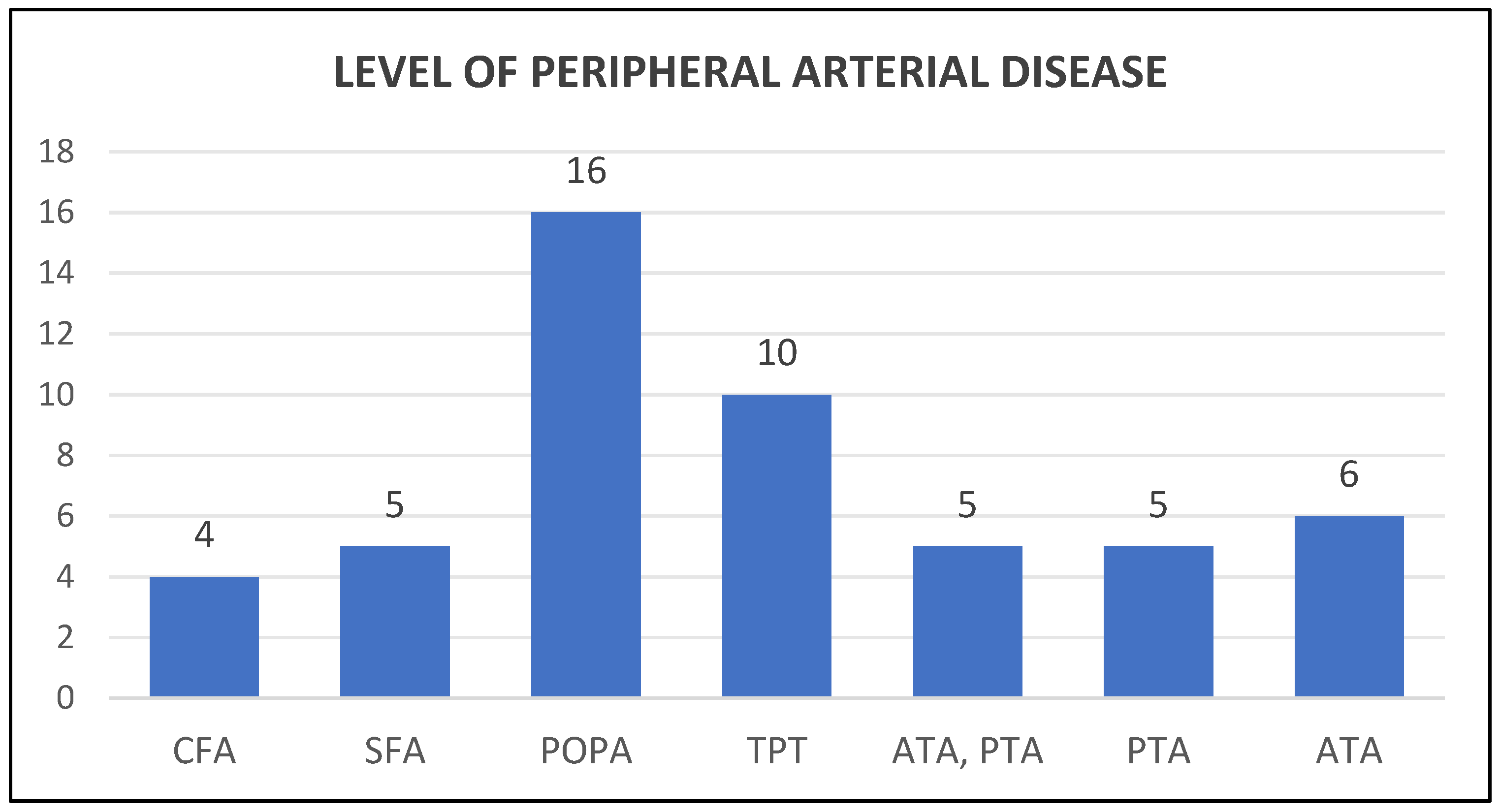
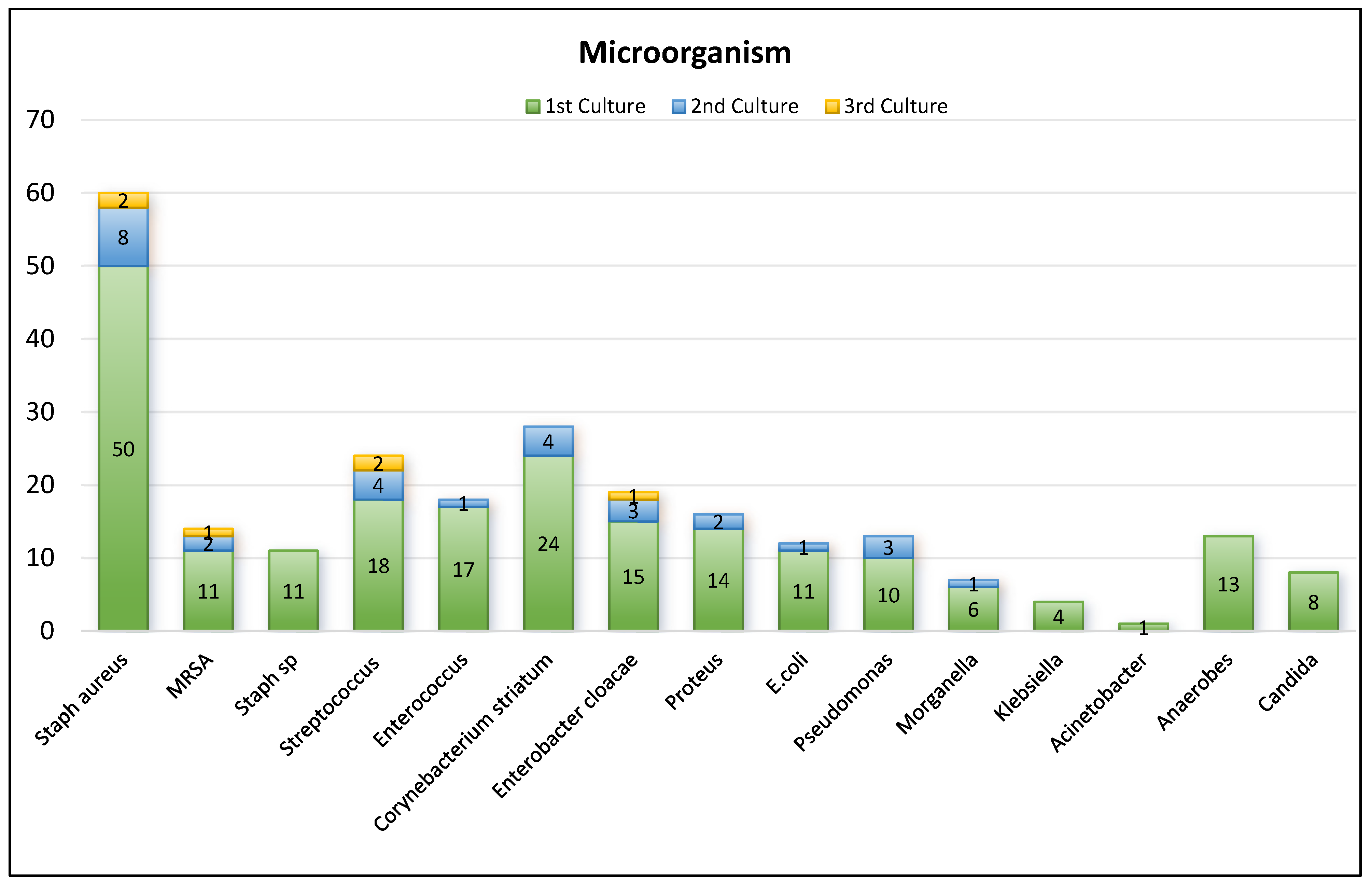
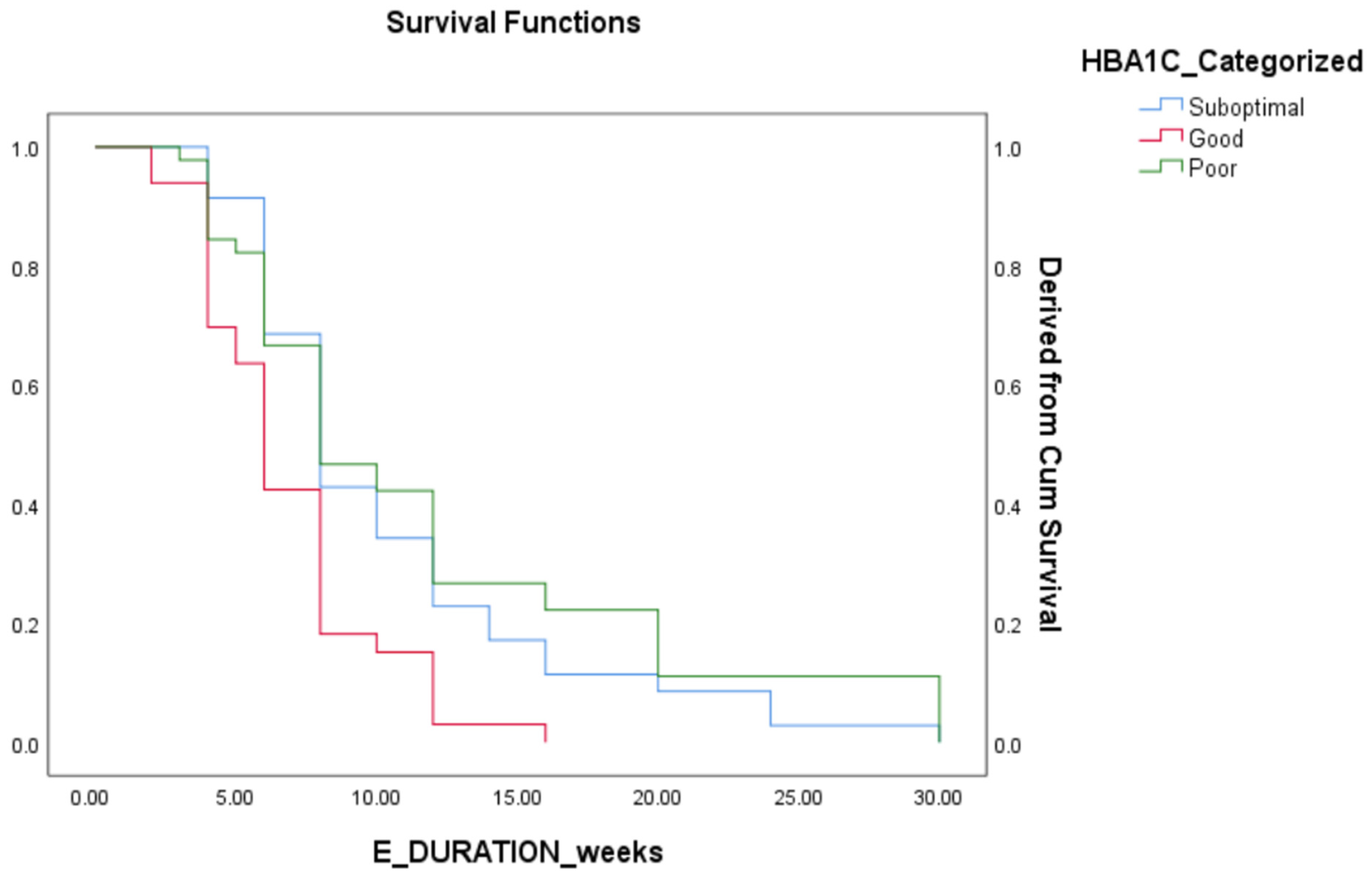
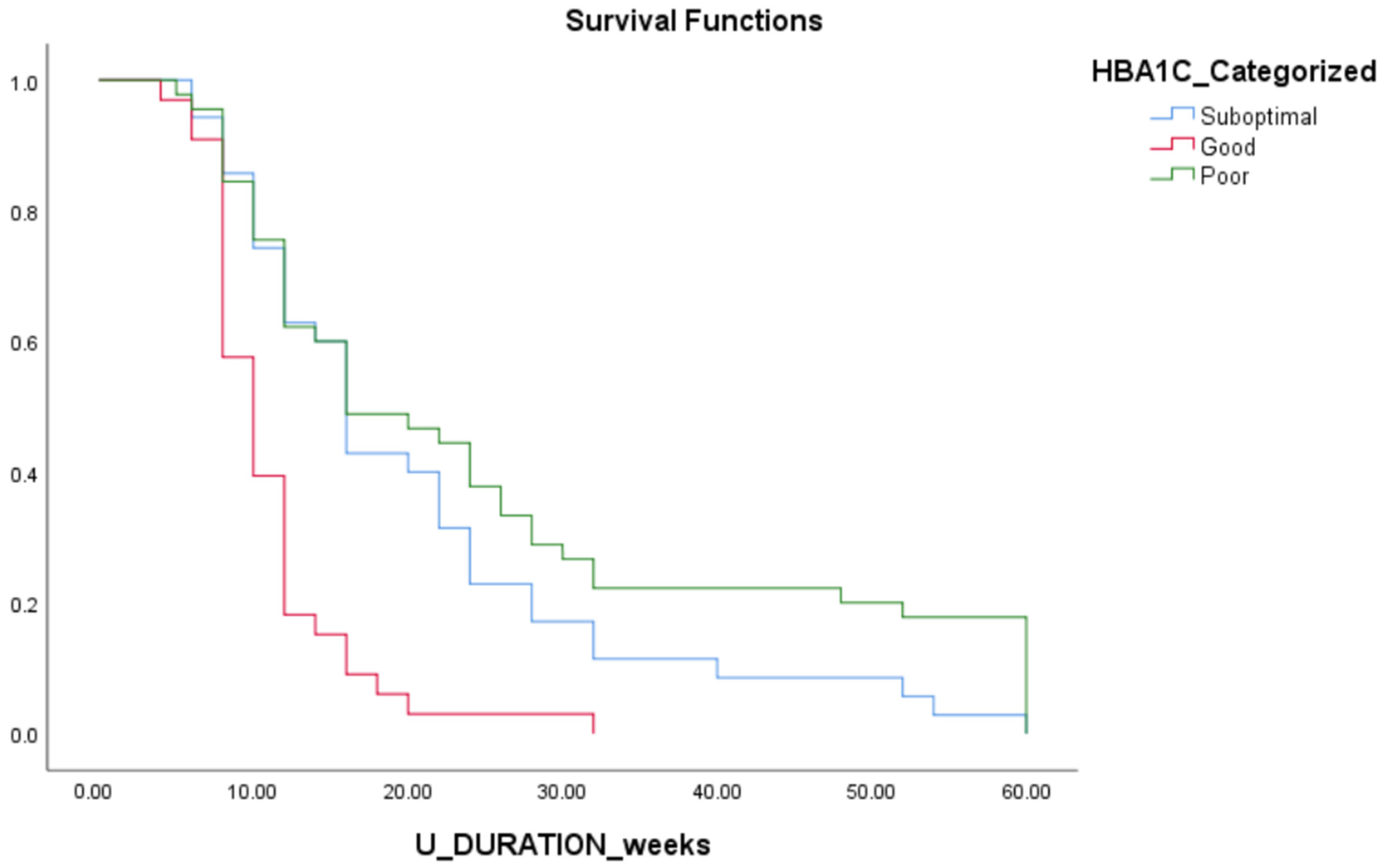
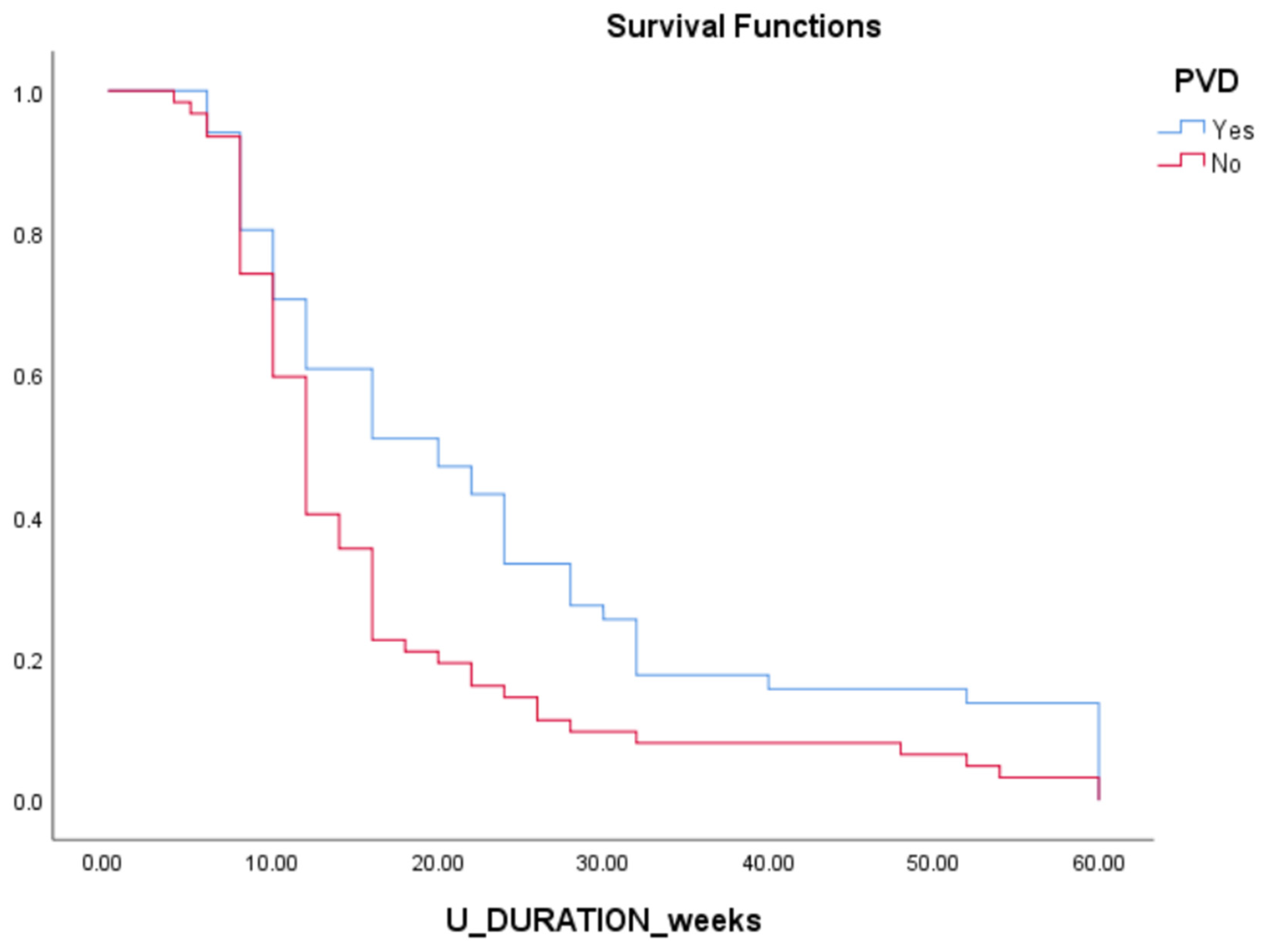
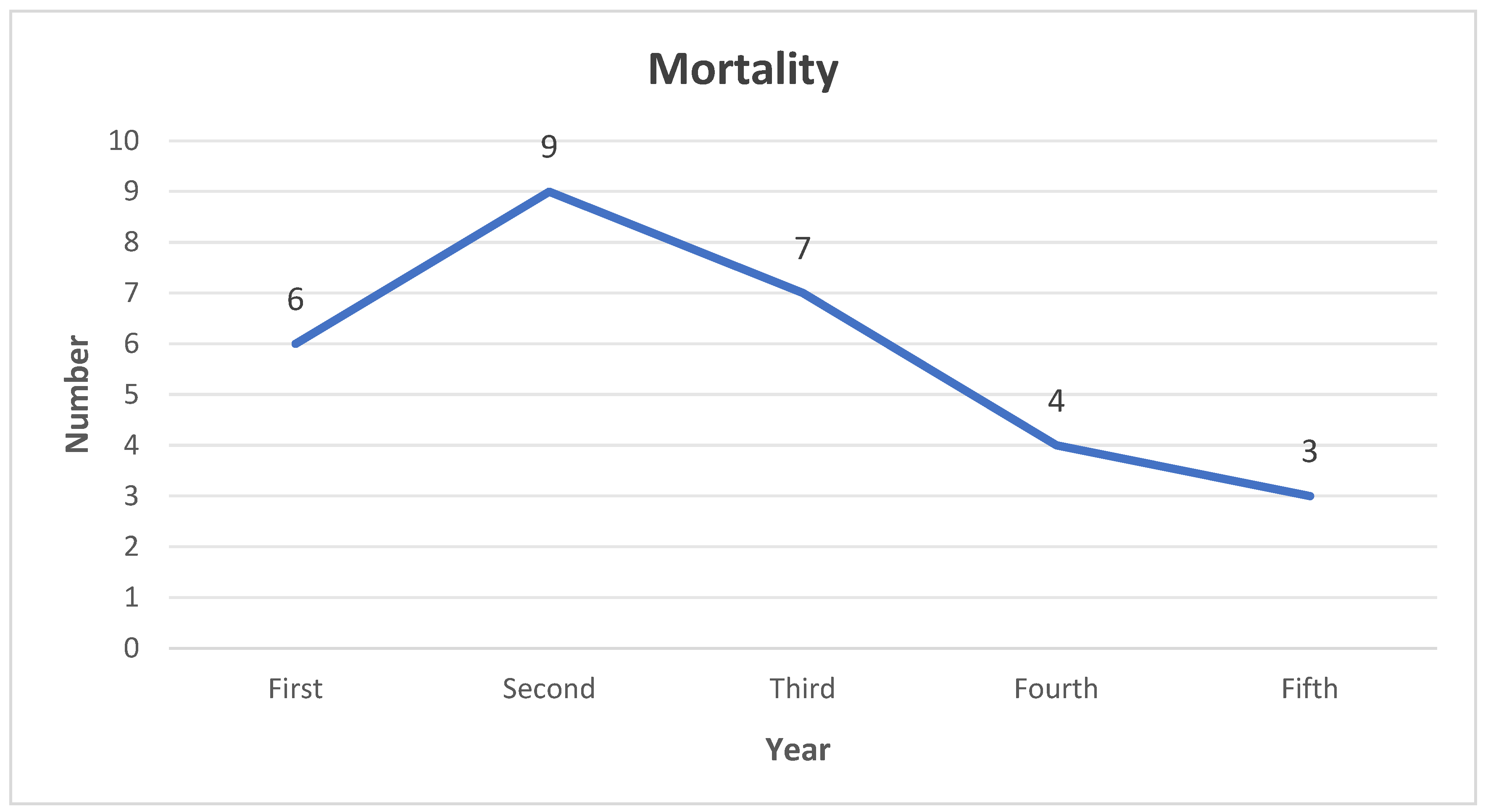
| Infection Eradication | Infection Eradication Duration | Ulcer Healing | Ulcer- Healing Duration | Recurrence of Ulcer | Limb Salvage | Mortality | |
|---|---|---|---|---|---|---|---|
| Age | 0.51 | 0.43 | 0.20 | 0.04 | 0.75 | 0.26 | 0.28 |
| Gender | 0.33 | 0.38 | 0.09 | 0.08 | 0.11 | 0.17 | 0.25 |
| BMI | 0.54 | 0.04 | 0.74 | 0.11 | 0.16 | 0.28 | 0.18 |
| Smoker | 0.33 | 0.18 | 0.18 | 0.19 | 0.07 | 0.18 | 0.29 |
| Part of Foot | 0.20 | 0.56 | 0.32 | 0.72 | 0.23 | 0.15 | 0.73 |
| Charcot | 0.46 | 0.55 | 0.43 | 0.29 | 0.18 | 0.24 | 0.08 |
| PAD | 0.02 | 0.04 | 0.02 | 0.07 | 0.00 | 0.05 | 0.15 |
| CKD | 0.38 | 0.22 | 0.63 | 0.40 | 0.31 | 0.27 | 0.00 |
| HBA1C | 0.15 | 0.07 | 0.02 | 0.00 | 0.01 | 0.07 | 0.07 |
| CRP | 0.34 | 0.19 | 0.17 | 0.09 | 0.01 | 0.27 | 0.02 |
| Poly/Mono | 0.42 | 0.20 | 0.70 | 0.28 | 0.33 | 0.35 | 0.51 |
| Gram Stain | 0.58 | 0.22 | 0.92 | 0.12 | 0.22 | 0.26 | 0.87 |
| Antibiotics | 0.22 | 0.38 | 0.36 | 0.03 | 0.13 | 0.86 | 0.76 |
| Cerament | 0.28 | 0.09 | 0.13 | 0.21 | 0.19 | 0.21 | 0.09 |
Disclaimer/Publisher’s Note: The statements, opinions and data contained in all publications are solely those of the individual author(s) and contributor(s) and not of MDPI and/or the editor(s). MDPI and/or the editor(s) disclaim responsibility for any injury to people or property resulting from any ideas, methods, instructions or products referred to in the content. |
© 2025 by the authors. Licensee MDPI, Basel, Switzerland. This article is an open access article distributed under the terms and conditions of the Creative Commons Attribution (CC BY) license (https://creativecommons.org/licenses/by/4.0/).
Share and Cite
Tai, K.M.; Mooteeram, J.; Metaoy, S.; Pillai, A. Antibiotic-Loaded Hydroxyapatite Ceramic in the Management of Diabetic Foot Osteomyelitis: An Investigation of Factors That Determine Patient Outcomes. BioMed 2025, 5, 11. https://doi.org/10.3390/biomed5020011
Tai KM, Mooteeram J, Metaoy S, Pillai A. Antibiotic-Loaded Hydroxyapatite Ceramic in the Management of Diabetic Foot Osteomyelitis: An Investigation of Factors That Determine Patient Outcomes. BioMed. 2025; 5(2):11. https://doi.org/10.3390/biomed5020011
Chicago/Turabian StyleTai, Ken Meng, Justin Mooteeram, Sara Metaoy, and Anand Pillai. 2025. "Antibiotic-Loaded Hydroxyapatite Ceramic in the Management of Diabetic Foot Osteomyelitis: An Investigation of Factors That Determine Patient Outcomes" BioMed 5, no. 2: 11. https://doi.org/10.3390/biomed5020011
APA StyleTai, K. M., Mooteeram, J., Metaoy, S., & Pillai, A. (2025). Antibiotic-Loaded Hydroxyapatite Ceramic in the Management of Diabetic Foot Osteomyelitis: An Investigation of Factors That Determine Patient Outcomes. BioMed, 5(2), 11. https://doi.org/10.3390/biomed5020011







